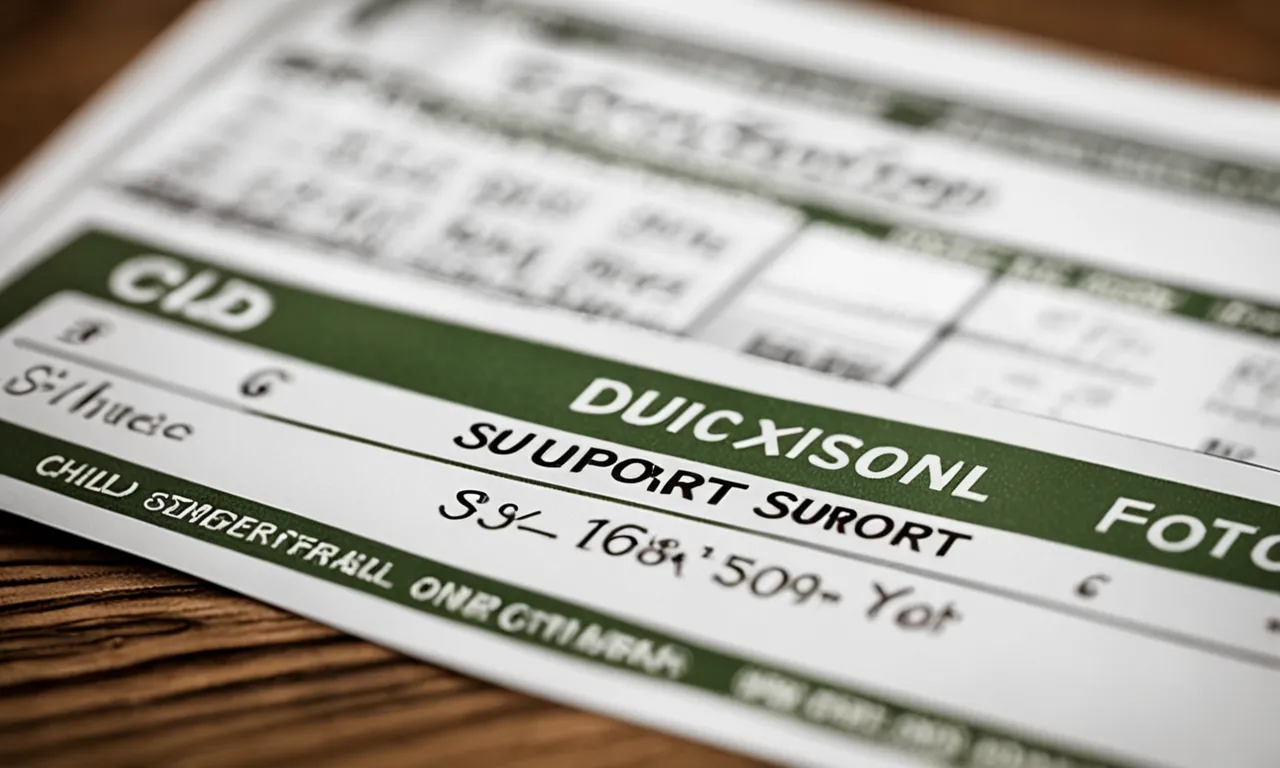How Does Child Support Appear On A Pay Stub?
If you or your partner pay child support, you may be curious about how those deductions show up on your pay stub. Seeing unfamiliar deductions can raise questions about what is being withheld and where that money is going.
If you’re short on time, here’s a quick answer to your question: Child support payments typically appear as payroll deductions on pay stubs under categories like “Garnishments” or “Wage Assignments.” The amount withheld will match court orders and may include processing fees.
In this comprehensive guide, we will explain in detail how to understand child support deductions on your pay stub. We’ll cover what child support payments may be labeled as, how amounts are determined, how frequently they are withheld, and where the money goes after being deducted from your check.
What Child Support Deductions May Be Called on Pay Stubs
When it comes to child support, it’s important to understand how it appears on a pay stub. Child support deductions are typically labeled in various ways, depending on the state and the employer’s payroll system.
Here are some common labels you may come across:
Garnishments or Wage Assignments
One common label you may see on your pay stub is “garnishment” or “wage assignment.” These terms refer to the court-ordered deduction of child support directly from your paycheck.
The amount withheld is usually based on a percentage of your income and is sent to the custodial parent or the state agency responsible for distributing child support payments.
Alimony or Spousal Support
In some cases, child support may be combined with alimony or spousal support payments. This means that the deduction on your pay stub may be labeled as “alimony” or “spousal support” instead of specifically mentioning child support.
It’s important to review your court order or divorce agreement to understand the breakdown of these payments.
Other Possible Labels
Child support deductions can also be labeled in other ways. Some employers may simply use the term “child support” or “child maintenance” to indicate the deduction. Others may use abbreviations such as “CS” or “C/S.”
If you’re unsure about the specific label on your pay stub, it’s best to consult your employer’s payroll department for clarification.
It’s worth noting that child support deductions are typically pre-tax, meaning they are deducted from your income before taxes are calculated. This can help lower your taxable income and potentially reduce your overall tax liability.
For more information about child support and how it appears on pay stubs, you can visit the official website of your state’s child support agency or consult with a family law attorney.
How Child Support Payment Amounts Are Determined
When it comes to determining child support payment amounts, there are several factors that come into play. Each state has its own set of guidelines and formulas to calculate the appropriate amount.
These guidelines take into account various factors, including the income of both parents, the number of children involved, and the custody arrangement.
Let’s take a closer look at the process of determining child support payment amounts.
Based on State Guidelines
Child support payment amounts are primarily based on state guidelines. These guidelines are designed to ensure that children receive adequate financial support from both parents. The guidelines take into consideration the income of both parents, as well as the number of children involved.
Some states use a percentage-based formula, where a certain percentage of the non-custodial parent’s income is allocated for child support. Other states use an income shares model, which takes into account the income of both parents to determine the amount of support required.
It’s important to note that these guidelines can vary from state to state, so it’s essential to consult the specific guidelines for your jurisdiction.
Factors That Influence Amounts
While state guidelines provide a framework for determining child support payment amounts, there are additional factors that can influence the final amount.
These factors can include the needs of the child, the standard of living the child would have enjoyed if the parents had stayed together, and any special expenses related to the child’s education, healthcare, or extracurricular activities.
Additionally, the custody arrangement can also impact the amount of child support required. For example, if one parent has sole custody, the non-custodial parent may be required to pay a higher amount to cover the child’s expenses.
Modifications and Updates
Child support payment amounts are not set in stone and can be modified or updated over time. Changes in circumstances, such as a significant change in income for either parent, can warrant a modification in the child support payments.
It’s important for both parents to communicate any changes in their financial situation to ensure that the child support payment amounts remain fair and appropriate. If you believe that a modification is necessary, it’s advisable to consult with a family law attorney who can guide you through the process and help you navigate the legal requirements.
For more information on child support payment amounts and guidelines in your state, you can visit the Child Support Enforcement website or consult with a legal professional who specializes in family law.
How Often Child Support Comes Out of Paychecks
When it comes to child support payments, the frequency at which they are deducted from a paycheck can vary depending on the specific circumstances.
In most cases, child support payments are deducted on a regular basis from the paying parent’s paycheck. This ensures that the support is consistently provided for the child’s needs.
Weekly, Biweekly or Semimonthly Pay Periods
For individuals who are paid on a weekly, biweekly, or semimonthly basis, child support payments are often deducted from their paychecks at the same frequency. This means that a portion of the payment is withheld every week, every two weeks, or twice a month, depending on the pay schedule.
This regular deduction helps to ensure that the child receives the necessary financial support on a consistent basis.
Monthly Payments
In some cases, child support payments may be deducted on a monthly basis. This is typically the case for individuals who are paid on a monthly pay schedule.
The entire monthly amount of child support is withheld from the paycheck, ensuring that the child receives the necessary support for the entire month.
Lump Sum Withholdings
In certain situations, child support payments may be deducted as a lump sum from a paycheck. This is more commonly seen when there are arrears or past due amounts owed.
The lump sum withholding allows for a faster repayment of the outstanding balance, ensuring that the child receives the full amount owed.
It’s important to note that specific child support arrangements may vary depending on the laws and regulations of the jurisdiction in which the support order was issued. Individuals should consult with their legal counsel or refer to the relevant government websites for accurate and up-to-date information on how child support appears on their pay stubs.
Where Do Child Support Deductions Go?
When child support payments are deducted from an individual’s paycheck, they are typically sent to a State Disbursement Unit (SDU). The SDU is a centralized agency that is responsible for processing and distributing child support payments.
Its main purpose is to ensure that the child support payments are received and distributed in a timely manner.
State Disbursement Unit
The SDU acts as an intermediary between the paying parent, the custodial parent, and the court. Once the child support payment is deducted from the paying parent’s paycheck, it is then sent to the SDU. The SDU keeps a record of all child support payments received and disburses the funds to the custodial parent.
The SDU ensures that the child support payments are accurately and promptly distributed to the custodial parent by keeping detailed records and using a secure electronic payment system. This helps to minimize errors and ensures that the funds reach the intended recipient.
Custodial Parent Payment
Once the child support payment reaches the SDU, it is then disbursed to the custodial parent. The custodial parent is the parent who has primary custody of the child or children. The payments are typically made on a regular schedule, such as monthly or bi-weekly, depending on the court order.
The custodial parent can choose to receive the child support payments in various ways, including direct deposit into their bank account or through a prepaid debit card. This provides convenience and flexibility for the custodial parent to access the funds and use them for the child’s needs.
Fees for Processing
It’s important to note that there may be fees associated with the processing of child support payments. These fees are typically deducted from the child support payment before it is disbursed to the custodial parent. The fees may vary depending on the state and the specific services provided by the SDU.
The fees for processing child support payments are often used to cover the administrative costs of operating the SDU, such as maintaining the electronic payment system, managing records, and ensuring compliance with state and federal regulations.
For more information about child support payments and how they appear on a pay stub, you can visit the website of your state’s child support agency or the Administration for Children and Families.
Conclusion
Understanding how child support deductions appear on your pay stub removes some of the mystery behind these line items.
While confusing at first glance, garnishments, wage assignments, and other labels refer to court-ordered child support payments.
By checking your pay stub frequently and knowing how amounts are set, withheld, and distributed, you can ensure accuracy and meet your child support obligations.










